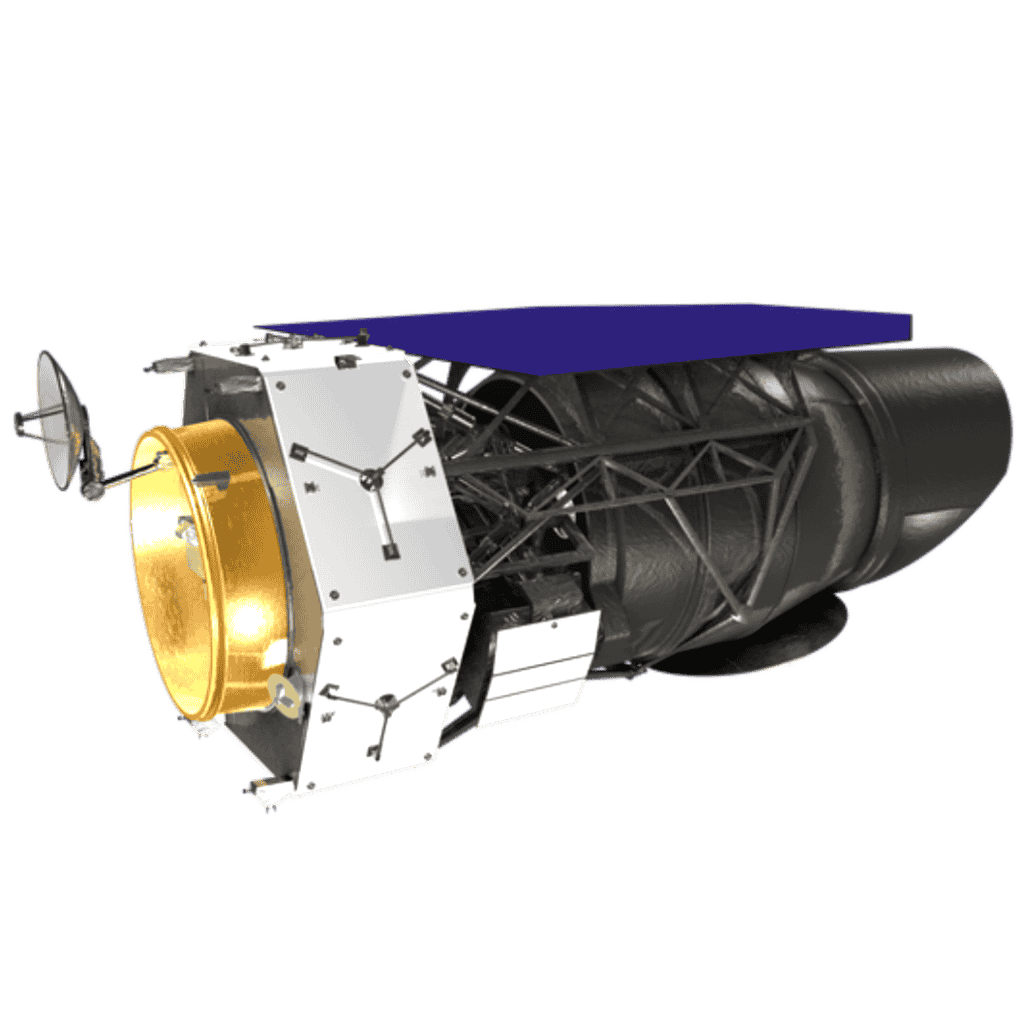Nancy Grace Roman Space Telescope
Wide-Field Observer
Wide-field infrared telescope for dark energy and exoplanet studies

USPs
- 2.4-meter mirror for large-scale surveys
- Studies dark energy and exoplanets
- Coronagraph for direct exoplanet imaging
- Wide-field instrument for rapid sky mapping
- Will collect 170 terabytes of data, more than Hubble’s total output
- Supports synergy with Euclid and JWST missions
- High-resolution imaging in visible and near-infrared
- Enables discovery of thousands of new exoplanets
Major Milestones
- 2010-05: Concept proposed as the Wide-Field Infrared Survey Telescope (WFIRST), laying the foundation for a mission to study dark energy and exoplanets.
- 2016-02-18: Selected by NASA for development, with a focus on a 2.4-meter mirror and wide-field imaging capabilities.
- 2019-03: Renamed the Nancy Grace Roman Space Telescope to honor the pioneering astronomer, marking a significant public milestone.
- 2021-06: Completed the critical design review, confirming the spacecraft's technical readiness for construction.
- 2023-04: Began integration of the primary mirror and Wide Field Instrument, advancing toward launch preparations.
- 2024-09: Completed the assembly of the spacecraft bus, a key step toward final integration and testing.
- 2025-03-15: Conducted successful environmental testing, ensuring the telescope can withstand launch and space conditions.
- 2025-07-17: Reached a major development milestone with ongoing integration, on track for a 2027 launch to study dark energy and exoplanets.
- 2027-05: Anticipated launch aboard a SpaceX Falcon Heavy, initiating its mission from Cape Canaveral (projected based on current plans).
- 2028-01: Expected to begin its primary survey mission, delivering the first wide-field infrared data on cosmic expansion (projected).
- 2028-06: First public data release expected, enabling global research collaborations (projected).
Cosmic Portrait
Nancy Grace Roman Space Telescope: Surveying the Cosmos
Nancy Grace Roman Space Telescope, often referred to simply as Roman, is NASA’s next flagship observatory scheduled for launch in 2026. This advanced space-based telescope will conduct wide-field infrared surveys of the universe, building on the legacy of the Hubble and James Webb Space Telescopes. Named after NASA’s first Chief of Astronomy, who played a crucial role in making Hubble a reality, Roman is poised to answer some of the most profound questions in cosmology, including the nature of dark energy and the formation of exoplanets.
- Technology & Optics: At its heart is a 2.4-meter primary mirror—the same size as Hubble’s—but coupled with a wide-field instrument that offers a field of view 100 times larger. This allows Roman to capture sweeping views of the universe with incredible resolution, making it ideal for large-scale sky surveys.
- Orbit & Positioning: Roman will operate from the second Sun–Earth Lagrange point (L2), located about 1.5 million kilometers from Earth. This position provides a thermally stable and unobstructed view of space, allowing for long-duration observations without Earth’s interference.
- Scientific Objectives: Roman’s core mission is twofold—first, to investigate the mysterious force known as dark energy that drives the accelerated expansion of the universe; and second, to explore the population of planets beyond our solar system using direct imaging and gravitational microlensing.
- Advanced Instrumentation: The Wide Field Instrument (WFI) will be used to observe billions of galaxies and thousands of supernovae, helping map the large-scale structure of the cosmos. The Coronagraph Instrument, an experimental technology demonstrator, will allow Roman to image exoplanets directly—something Hubble and Webb struggle to do with current instruments.
The Scientific Impact of Roman
Roman’s data will revolutionize multiple areas of astrophysics. Its dark energy survey will measure the distances to supernovae with unprecedented precision, while also mapping how galaxies cluster over time—both key for understanding the fate of the universe. On the exoplanet front, Roman is expected to detect thousands of new planets, including those that orbit far from their stars—an area still poorly understood. This makes it a vital piece of the puzzle in our search for potentially habitable worlds.
Roman is not flying solo. Its mission is designed to complement the European Space Agency’s Euclid telescope and NASA’s own James Webb Space Telescope (JWST). While JWST zooms in on specific cosmic phenomena with incredible detail, Roman will cast a wider net, providing the context needed to understand what JWST sees in depth. Together, they will offer a multi-layered view of the universe—broad and deep.
Why Roman Matters
Roman will reveal the cosmos in unprecedented detail, from distant galaxies to nearby exoplanets, bridging the gap between wide-angle surveys and focused observations.
This mission represents not just a leap in telescope design, but a shift in how we study the sky. By blending wide-field vision with powerful infrared sensitivity, Roman will allow us to watch the cosmic story unfold—from the birth of stars to the dance of planets and the growth of galaxies across time. It’s a tool for discovery, collaboration, and perspective—one that could reshape our understanding of the universe for generations to come.
Fun Fact
Roman will collect 170 terabytes of data, more than Hubble’s total output!